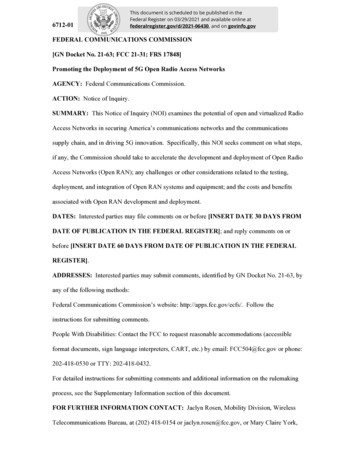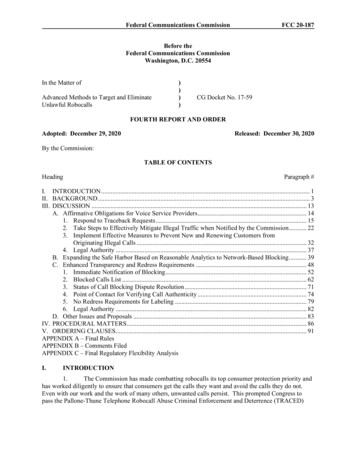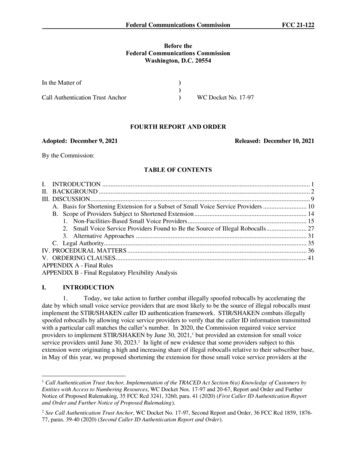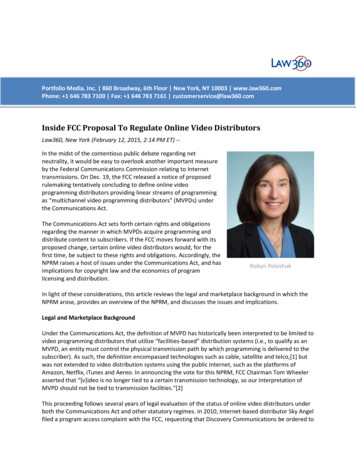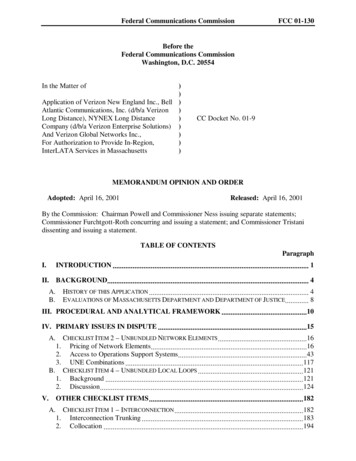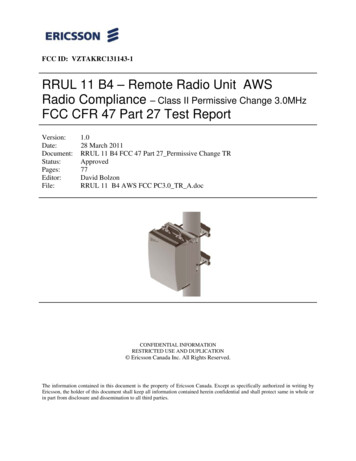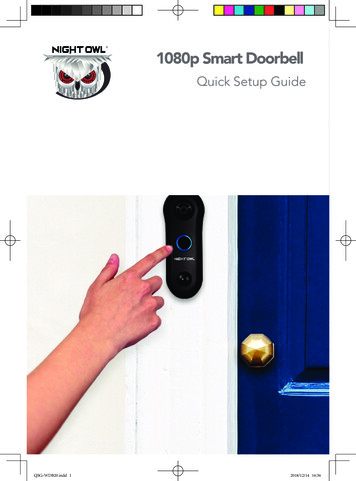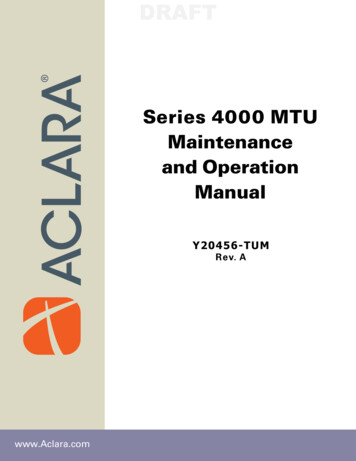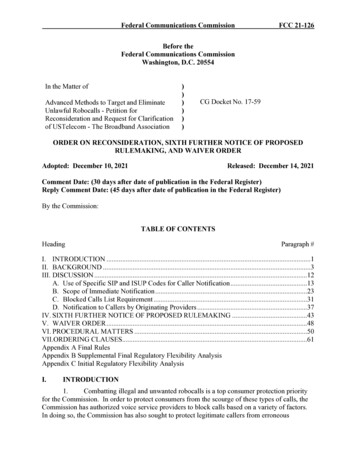
Transcription
Federal Communications CommissionFCC 21-126Before theFederal Communications CommissionWashington, D.C. 20554In the Matter ofAdvanced Methods to Target and EliminateUnlawful Robocalls - Petition forReconsideration and Request for Clarificationof USTelecom - The Broadband Association))))))CG Docket No. 17-59ORDER ON RECONSIDERATION, SIXTH FURTHER NOTICE OF PROPOSEDRULEMAKING, AND WAIVER ORDERAdopted: December 10, 2021Released: December 14, 2021Comment Date: (30 days after date of publication in the Federal Register)Reply Comment Date: (45 days after date of publication in the Federal Register)By the Commission:TABLE OF CONTENTSHeadingParagraph #I. INTRODUCTION .1II. BACKGROUND .3III. DISCUSSION .12A. Use of Specific SIP and ISUP Codes for Caller Notification.13B. Scope of Immediate Notification .23C. Blocked Calls List Requirement .31D. Notification to Callers by Originating Providers .37IV. SIXTH FURTHER NOTICE OF PROPOSED RULEMAKING .43V. WAIVER ORDER .48VI. PROCEDURAL MATTERS .50VII.ORDERING CLAUSES.61Appendix A Final RulesAppendix B Supplemental Final Regulatory Flexibility AnalysisAppendix C Initial Regulatory Flexibility AnalysisI.INTRODUCTION1.Combatting illegal and unwanted robocalls is a top consumer protection priorityfor the Commission. In order to protect consumers from the scourge of these types of calls, theCommission has authorized voice service providers to block calls based on a variety of factors.In doing so, the Commission has also sought to protect legitimate callers from erroneous
Federal Communications CommissionFCC 21-126blocking. The Commission has recognized that legitimate callers can provide importantinformation to consumers and that consumers often want to receive such calls.2.To balance protecting consumers from unwanted calls and callers fromerroneously blocked calls, the Commission adopted certain transparency and redressrequirements in the Call Blocking Fourth Report and Order.1 In this Order on Reconsideration,the Commission reconsiders and clarifies certain aspects of the transparency and redressrequirements adopted in the Call Blocking Fourth Report and Order to ensure that voice serviceproviders continue to block unwanted and illegal calls, while also protecting the interests oflegitimate callers and consumers. In the Sixth Further Notice of Proposed Rulemaking, theCommission seeks comment on whether to make permanent the flexibility afforded to callers inthe Order on Reconsideration. Finally, in the Waiver Order, we grant a waiver to allow voiceservice providers terminating a call on an IP network to use SIP Code 603 in addition to SIPCode 607 or 608 from January 1, 2022 until the effective date of the amendments to section64.1200(k)(9) adopted in the Order on Reconsideration.2II.BACKGROUND3.The Commission receives more complaints about unwanted calls than any otherissue. The Federal Trade Commission (FTC)4 and non-governmental entities report similarlyhigh numbers.5 Unwanted calls not only annoy consumers, they can defraud them and lead toidentity theft.6 In recent years, the Commission has fought the flood of robocalls with aggressive3Advanced Methods to Target and Eliminate Unlawful Robocalls, CG Docket No. 17-69, Fourth Report and Order,35 FCC Rcd 15221, 15239-47, paras. 48-78 (2020) (Call Blocking Fourth Report and Order).1Because we resolve the underlying issues in the Petition for Reconsideration, we dismiss as moot USTelecom’srequest to stay the January 1, 2022 deadline.2We received 185,000 such complaints in 2017, 232,000 in 2018, 193,000 in 2019, and 157,000 in 2020. FCC,Consumer Complaint Data Center, https://www.fcc.gov/consumer-help-center-data (last visited Oct. 19, 2021).Thus far in 2021, we have received 139,000 such complaints. Id. Multiple factors can affect these numbers,including outreach efforts and media coverage on how to avoid unwanted calls. Complaint numbers declinedsignificantly during the first four months of the COVID-19 pandemic, reducing the total number of complaints theCommission received in 2020.3In fiscal year 2019, the FTC received an average of 315,000 robocall complaints per month. FTC, Biennial Reportto Congress Under the Do Not Call Registry Fee Extension Act of 2007 at 3 do-not/p034305dncreport2019.pdf.4For example, according to Hiya’s State of the Calls Report, 50 billion unwanted robocalls were placed to U.S.mobile phones in 2020. See Adam Rowe, tech.co, “Americans Got 50 Billion Spam Calls Last Year,” Feb. 11,2021, ls (last visited Oct. 20, 2021). Similarly, YouMailestimates that 38.7 billion robocalls were placed nationwide so far in 2021. YouMail, Historical Robocalls By Time,https://robocallindex.com/history/time (last visited Oct. 20, 2021).5Significant scams include impersonation of Internal Revenue Service or Social Security Administration agents,among others. See, e.g., FCC and TIGTA Warn Consumers of IRS Impersonation Phone Scam: Scam Has CostVictims Tens of Millions of Dollars, Enforcement Advisory, 31 FCC Rcd 13184 (EB 2016) (warning consumers ofscam callers claiming to be from the Internal Revenue Service and in which Caller ID is spoofed to display an IRStelephone number or “IRS”); Internal Revenue Service, IRS: Be Vigilant Against Phone Scams; Annual “DirtyDozen” List Continues (Mar. 5, 2019), st-phone-scamsannualdirty-dozen-list-continue; Federal Trade Commission, Getting Calls from the SSA? (Mar. 6, tting-calls-ssa.62
Federal Communications CommissionFCC 21-126enforcement and policy action, including authorizing voice service providers to block unwantedand/or illegal calls in certain circumstances.4.The 2017 Call Blocking Order empowered voice service providers to blockcertain categories of calls that are highly likely to be illegal without consumer consent—callspurporting to be from invalid, unallocated, or unused numbers, for example.7 The Commissionfurther addressed blocking in 2019, when it made clear that voice service providers may blockcalls based on reasonable analytics designed to identify unwanted calls without consumershaving to take any action, as long as consumers can opt out of the blocking service.8 It alsomade clear that voice service providers could block all calls not on a consumer’s white list on anopt-in basis.95.In 2019, Congress passed a landmark anti-robocall law, the Pallone-ThuneTelephone Robocall Abuse Criminal Enforcement and Deterrence Act (TRACED Act).10 TheCommission implemented the TRACED Act and expanded on its 2019 actions in the July 2020Call Blocking Order by establishing a safe harbor from liability under the Communications Actand the Commission’s rules for erroneous call blocking.11 Specifically, this safe harbor protectsvoice service providers from liability under the Communications Act and the Commission’s rulesfor the unintended or inadvertent blocking of wanted calls where terminating voice serviceproviders block calls thought to be illegal or unwanted based on reasonable analytics that includecaller ID authentication information and where the consumer is given the opportunity to optout.126.In the December 2020 Call Blocking Fourth Report and Order, the Commissionexpanded a safe harbor from liability under the Communications Act and the Commission’s rulesfor network-based blocking based on reasonable analytics that incorporate caller IDauthentication information designed to identify calls that are highly likely to be illegal, if thisblocking is managed with human oversight and network monitoring sufficient to ensure thatblocking is working as intended.13 Because the Commission determined that such blockingwould permit providers to block calls “no reasonable consumer would want to receive (thoseSee generally 47 CFR § 64.1200(k)(1)-(2); Advanced Methods to Target and Eliminate Unlawful Robocalls, CGDocket No. 17-59, Report and Order and Further Notice of Proposed Rulemaking, 32 FCC Rcd 9706, 9709-25,paras. 9-56 (2017) (2017 Call Blocking Order).7See Advanced Methods to Target and Eliminate Unlawful Robocalls, Call Authentication Trust Anchor, CGDocket No. 17-59, WC Docket No. 17-97, Declaratory Ruling and Third Further Notice of Proposed Rulemaking,34 FCC Rcd 4876, 4884-90, paras. 26-42 (2019).89Id. at 4890-91, paras. 43-46.Pallone-Thune Telephone Robocall Abuse Criminal Enforcement and Deterrence Act, Pub. L. No. 116-105, 133Stat. 3274 (2019) (TRACED Act).1011See 47 CFR § 64.1200(k)(3); Call Blocking Order and Further Notice, 35 FCC Rcd. at 7625-3-27 paras. 25-34.See Call Blocking Order and Further Notice, 35 FCC Rcd at 7625-27, paras. 25-34. This program must also befree of line-item charges to the consumer. Id. at 7625, para. 25. The Order also established a second safe harborthat protects voice service providers that block calls from bad-actor upstream providers that fail to mitigate badtraffic within 48 hours or take effective steps to prevent new and renewing customers from originating illegal trafficafter the Commission notifies them of that traffic. Id. at 7627-31, paras. 35-45.12See 47 CFR § 64.1200(k)(11); Call Blocking Fourth Report and Order, 35 FCC Rcd at 15234-37, paras. 39-46.In expanding this safe harbor, the Commission also adopted further requirements that all voice service providerstake steps to stop illegal traffic on their networks and assist the Commission, law enforcement, and the TracebackConsortium in tracking down callers that make such calls. Id. at 15226, para. 13.133
Federal Communications CommissionFCC 21-126calls that are highly likely to be illegal),” the Commission determined that such blocking doesnot require voice service providers to establish an opt-out mechanism.14 Further, pursuant to theTRACED Act’s requirement that the Commission take action to ensure that both callers andconsumers receive transparency and effective redress for robocall blocking services provided onan opt-out or opt-in basis,15 the Call Blocking Fourth Report and Order requires that voiceservice providers that block calls disclose such blocking, establish a dispute resolution process tocorrect erroneous blocking, and promptly resolve disputes.167.As part of these requirements, the Commission required that voice serviceproviders blocking calls provide immediate notification to callers of such blocking through theuse of specified Session Initiation Protocol (SIP) Codes.17 SIP is the signaling protocol used inIP networks enabling calls to be made and received by end-users. SIP calls include both a SIPrequest and a SIP response, and the SIP response comes in the form of a three-digit code thatindicates the status of the SIP request, such as whether it was accepted. SIP Codes in the 600range notify a caller when their call has failed to reach the intended recipient. The Commissionspecified that terminating voice service providers that block calls on an IP network return SIPCode 607 or 608, as appropriate.18 Because SIP Codes are not available on non-IP networks, theCommission required use of ISUP code 21 for calls blocked on a TDM network.198.In adopting this requirement, the Commission acknowledged that callers mayreceive SIP Code 603 when calls have been blocked.20 The Commission stated that this is “likelyto occur when call signaling transits from TDM to IP.”21 The Call Blocking Fourth Report andOrder further required “all voice service providers in the call path” to transmit the appropriateSIP Codes to “the origination point” of the call.22 The Commission set a deadline of January 1,14See 47 CFR § 64.1200(k)(11); Call Blocking Fourth Report and Order, 35 FCC Rcd at 15234, para. 39 n.89.15See TRACED Act § 10(b) (codified at 47 U.S.C. § 227(j)).Call Blocking Fourth Report and Order, 35 FCC Rcd at 15238-47, paras. 48-78 (to be codified at 47 CFR §64.1200(k)(8)-(10)).16Call Blocking Fourth Report and Order, 35 FCC Rcd at 15239, para. 52 (to be codified at 47 CFR §64.1200(k)(9)).17Call Blocking Fourth Report and Order, 35 FCC Rcd at 15240, para. 56 (to be codified at 47 CFR §64.1200(k)(9)(i)). SIP Codes 607 and 608 are defined by the IETF to be used in the call blocking context. InternetEngineering Task Force, A SIP Code for Unwanted Calls (July 2017), https://tools.ietf.org/html/rfc8197 (SIP Code607 Specification); Internet Engineering Task Force, A Session Initiation Protocol (SIP) Response Code for RejectedCalls (Dec. 2019), https://tools.ietf.org/html/rfc8688 (SIP Code 608 Specification). Code 607 is used when thecalled party indicates a call is unwanted. SIP Code 607 Specification. Code 608, however, indicates a call wasrejected by an intermediary, with the initial use case being calls rejected by an analytics engine, as opposed to by thecalled party. SIP Code 608 Specification. We expect that most blocking offered by IP-based voice serviceproviders will use code 608. We recognize, however, that code 607 may be more appropriate when the called partyplays a role in the rejection, e.g., when the caller is not on a customer’s white list.18Call Blocking Fourth Report and Order, 35 FCC Rcd at 15240, para. 56 (to be codified at 47 CFR §64.1200(k)(9)(ii)).1920Id. at para 57.21Id.Call Blocking Fourth Report and Order, 35 FCC Rcd at 15238, para. 49 (to be codified at 47 CFR §64.1200(k)(9)).224
Federal Communications CommissionFCC 21-1262022 for voice service providers to comply with the immediate notification requirements.23Additionally, the Commission required that any terminating voice service provider that blockscalls on an opt-in or opt-out basis provide, on the request of the subscriber to a particularnumber, a list of all calls intended for that number that the voice service provider or its designeehas blocked.249.On May 6, 2021, USTelecom filed a petition seeking reconsideration andclarification of certain portions of the transparency and redress requirements adopted in the CallBlocking Fourth Report and Order.25 First, the Petition asks the Commission to “[m]ake clearthat service providers have flexibility to select the appropriate code or tool to notify callers thattheir calls have been blocked,” rather than requiring use of SIP Codes 607 or 608.26 Second, thePetition asks the Commission to “[c]onfirm that voice service providers only are required andexpected to provide notification of blocking when calls are blocked based on opt-in or opt-outanalytics programs, and not in contexts where those requirements do not make sense.”27Similarly, the Petition asks the Commission to clarify that the blocked calls list “need onlyinclude calls blocked based on a provider’s opt-in [or] opt-out analytics-based robocall blockingservices, and not based on other features selected by the customer.”28 Finally, the Petition seeksconfirmation that “voice service providers serving enterprises and other organizations have theflexibility to work with those customers to determine the best approach to notification on a caseby-case basis.”2910.The Consumer and Governmental Affairs Bureau sought comment on this Petitionon May 11, 2021.30 The Commission received comments from 12 parties, representing both thecalling industry and voice service providers.11.USTelecom supplemented its request in an ex parte filed on July 27, 2021.31 Inthis ex parte, USTelecom proposes allowing providers to use SIP Code 603 for blockingnotifications “in the short term” and argues that this SIP Code is both useful for callers andtechnically feasible for voice service providers.32 USTelecom argues that, “SIP Code 603 is theonly way providers can implement a return code in the short term.”33 USTelecom states that,Call Blocking Fourth Report and Order, 35 FCC Rcd at 15242, para. 61 (to be codified at 47 CFR §64.1200(k)(10)).2324Call Blocking Fourth Report and Order, 35 FCC Rcd at 15242-45, paras. 62-69.Petition for Reconsideration and Request for Clarification of USTelecom - The Broadband Association, May 6,2021 (Petition).2526Petition at 2.Petition at 3. USTelecom argues that providers should not be required to provide any form of notification whenthey block calls for certain reasons, such as when a numbers are on the Do-Not-Originate list, are part of a suspectedTelephone Denial of Service attack, or are blocked pursuant to a customer-initiated mechanism. Id.2728Petition at 13.29Petition at 3.30Petition for Reconsideration of Action in Proceedings, Report No. 3173, Public Notice (CGB May 11, 2021).See Letter from Joshua M. Bercu, Vice President, Policy & Advocacy, USTelecom to Marlene Dortch, Secretary,Federal Communications Commission, CG Docket No. 17-59 (filed Jul. 27, 2021) (USTelecom July 2021 Ex Parte).3132Id. at 1.33Id. at 1 (footnotes omitted).5
Federal Communications CommissionFCC 21-126“SIP Code 603 will meet callers’ needs. A uniform return code, even without the jCard, givescallers actionable information: They know to investigate the issue and can take proactivesteps.”34 Finally, USTelecom argues that, even if the Commission mandates use of SIP Code603, it should still provide voice service providers with flexibility for other “appropriate responsecodes that are still in development through the industry standards bodies,” as this would allow“further refinement to notification in the future.”35 USTelecom states that if a provider cannotmeet the notification requirement, “the provider’s only option is to stop blocking illegal andunwanted robocalls or to never start blocking those calls in the first instance.”36III.DISCUSSION12.In this Order on Reconsideration, we grant in part and deny in part USTelecom’sPetition to the extent described herein. First, we grant USTelecom’s request that we allow voiceservice providers operating IP networks the flexibility to use SIP Code 603 to meet theimmediate notification requirement beginning on January 1, 2022.37 We deny USTelecom’srequest to allow terminating voice service providers the flexibility not to provide immediatenotification of blocking by means of the designated SIP or ISUP codes. Next, we grantUSTelecom’s request that we clarify that our immediate notification requirements apply to allanalytics-based blocking, and do not apply to non-analytics-based blocking programs. Third, weclarify that our blocked calls list requirements apply only to opt-in or opt-out analytics-basedblocking and not to other blocking programs. Finally, we deny USTelecom’s request that weallow originating voice service providers to choose the method by which they notify enterprisecallers of a blocked call.A.Use of Specific SIP and ISUP Codes for Caller Notification13.We find that allowing terminating voice service providers to utilize SIP Code 603during the finalization of and transition to SIP Codes 607 and 608 strikes a reasonable balancebetween ensuring that voice service providers have the technical ability to provide immediatenotification to callers and ensuring that callers have a uniform means of receiving suchnotifications. As a result, we amend our immediate notification requirements to allowterminating voice service providers operating IP networks to use SIP Codes 603, 607, or 608 tocomply with the rule. We therefore grant USTelecom’s request to allow use of SIP Code 603 asan alternative to SIP Codes 607 and 608, but we deny USTelecom’s broader request for general“flexibility” with regard to providing blocking notification.14.We agree with caller commenters that argue for the need for a consistent anduniform notification requirement.38 As Ad Hoc Telecom Users Committee (Ad Hoc) argues,allowing providers to choose any means of immediate notification of blocked calls wouldId. at 2. According to TNS, a jCard is an optional feature of SIP Code 608 that gives callers contact informationto seek redress for a blocked call. See Letter from Steven A. Augustino, Counsel, Transaction Network Services,Inc., to Marlene H. Dortch, Secretary, FCC at 2 (Aug. 26, 2021) (TNS Ex Parte).3435Id.36USTelecom July 2021 Ex Parte at 2.Although the rule states “all voice service providers in the call path must transmit[] an appropriate response code,”we focus in this order on the terminating voice service provider, as it is the terminating voice service provider thatselects the appropriate response code to return to the caller to provide immediate notification.3738See, e.g., Ad Hoc Comments at 2-3.6
Federal Communications CommissionFCC 21-126“increase confusion for legitimate callers.”39 We agree that legitimate callers should not beexpected to navigate a variety of potential notification schemes to determine whether their callshave been blocked.40 Rather, having a uniform immediate notification scheme is critical tomeeting the TRACED Act’s requirement for transparency and effective redress. Based on therecord, we believe the best method of advancing this goal is through the use of available SIPCodes that provide real-time data to callers.41 Additionally, as ABA notes, many callers alreadycan, or will be able to, receive and make use of SIP Codes, making such codes and theinformation they convey useful to callers.42 Expanding the requirement to allow for use of oneadditional SIP Code for a period of time will not impose new burdens on either callers or voiceservice providers and best addresses the interests of all parties.4315.We also agree with voice service providers that implementing SIP Code 607 or608 by January 1, 2022 appears infeasible.44 Voice service providers have been clear that thereare a number of steps necessary before they can implement SIP Codes 607 or 608, includingstandards finalization, software design and testing, and interoperability mapping.45 Thesehurdles, while surmountable, appear to require additional time. We agree with CTIA thatmandating the deployment of SIP Codes 607 or 608 at this time, “could work against theAd Hoc Comments at 2-3. See also INCOMPAS Comments at 8-9 (“Callers and originating service providersthat service them should not be expected to modify their systems to receive multiple forms of notification that eachblocking entity separately decides best satisfies effective notice.”). INCOMPAS filed its comments jointly with theCloud Communications Alliance (CCA).3940Ad Hoc Comments at 3.See Ad Hoc Comments at 4 (arguing that a unique, real-time indicator is the only way for callers to reliably knowwhen calls are blocked); Voice on the Net Comments at 3 (“ without SIP response codes, expanded call blockingbased on analytics would be invisible to the called party, the calling party, and the originating voice serviceprovider”).41See ABA Comments at 5-6. ABA filed comments jointly with ACA International, American Association ofHealthcare Administrative Management, American Financial Services Association, Credit Union NationalAssociation, Mortgage Bankers Association, National Association of Federally-Insured Credit Unions, NationalCouncil of Higher Education Resources, National Retail Federation, and Student Loan Servicing Alliance.42See Letter from Laura H. Phillip, Counsel for the National Opinion Research Center, to Marlene Dortch,Secretary, Federal Communications Commission, CG Docket No. 17-59, at 1-2 (filed June 17, 2021) (arguing that“flexibility” would return the situation back to the status quo, where many carriers failed to provide prompt andreasonable notice, and often provided no notice) (National Opinion Research Center Ex Parte).43See, e.g., Lumen Comments at 7 (noting a number of steps are necessary before implementation and arguing thatit will require more time); NCTA Comments at 2-3 (arguing that the SIP Code requirements are based on “anunfinished standard” and may not be actually implementable); Verizon Comments at 5-6 (arguing that theCommission should let the standards process play out before implementing a SIP Code 607 or 608 requirement);USTelecom Reply at 3; TNS Ex Parte at 2 (arguing that there are numerous technical and cost considerationsimpeding use of 607 or 608). But see, Ad Hoc Comments at 5 (arguing that the Petition “provided no evidenceindicating that carriers will be unable to meet the January 2022 notification implementation from a technicalperspective”); ABA Comments at 6 (arguing that the Petition “does not address why the Commission’s solution isnot sufficient until a specific mapping standard for ISP Codes 607 and 608 is finalized”); Letter from Joshua M.Bercu, Vice President, Policy & Advocacy, USTelecom, to Marlene Dortch, Secretary, FCC, CG Docket No. 17-59(Oct. 19, 2021); Letter from Linda Vandeloop, AT&T, to Marlene H. Dortch, Secretary, FCC, CG Docket No. 17-59(Oct. 21, 2021) (AT&T Oct. 2021 Ex Parte) (arguing that SIP Code 603 already exists and can be implemented“reasonably quickly and efficiently . . . . AT&T believes it can be ready to return the 603 SIP code to notify callersof the blocking of calls by the January 1, 2022 [deadline].”); Letter from Alexi Maltas, SVP & General Counsel,Competitive Carriers Association, to Marlene H. Dortch, Secretary, FCC, CG Docket No. 17-59 (Nov. 18, 2021).4445See Lumen Comments at 7; USTelecom Reply at 3.7
Federal Communications CommissionFCC 21-126Commission’s goals and hinder robocall abatement efforts by discouraging providers fromblocking the illegal and unwanted calls to protect consumers, as providers will not be encouragedto block calls if they are not technically able to comply with the accompanying blocked-callnotification requirement.”46 As consumer groups have noted, requiring immediate use of SIPCodes 607 or 608 could force voice service providers to cease their blocking programs.47 Weagree with such commenters that this will result in more illegal and unwanted calls, underminingthe Commission’s goal of protecting consumers from such calls.48 As a result, we believe thatproviding voice service providers the flexibility to use SIP Code 603 for immediate notificationsis appropriate at this time.16.Because SIP Code 603 is already in use and available to voice service providersand to callers with the appropriate equipment, we see no reason to delay the effective date of ourimmediate notification requirement.49 Again, retaining the effective date of the immediatenotification requirement while allowing for the use of an additional SIP Code to meet therequirement strikes a reasonable balance between uniformity for callers and technical ability forvoice service providers. It also helps ensure that voice service providers continue to block illegaland unwanted calls, a critical consumer protection objective.50 We note that nothing in this orderprohibits a voice service provider from using SIP Codes 607 or 608 to meet its immediatenotification obligations. Rather, the only change to our rule is allowing flexibility for voiceservice providers to use SIP Code 603. By allowing terminating voice service providers to usean existing SIP Code while transitioning to full implementation of SIP Codes 607 and 608, wemitigate voice service providers’ concerns that requiring SIP Codes 607 or 608 will discourageuse of call blocking tools.5117.Additionally, allowing for use of SIP Code 603 will help “ensure that notificationof blocking is uniform, clear, and distinct from other signals, such as a busy signal, and ensurethat callers can act on this information.”52 We agree with USTelecom that “SIP Code 603 willmeet callers’ needs. A uniform return code, even without the jCard, gives callers actionableLetter from Sarah K. Leggin, Director, Regulatory Affairs, CTIA to Marlene H. Dortch, Secretary, FCC (Sep. 10,2021) (CTIA Ex Parte).46See Letter from Margot Saunders, Senior Counsel, National Consumer Law Center, to Marlene Dortch, Secretary,FCC, CG Docket No. 17-59 (Nov. 9, 2021) (NCLC Nov. 2021 Ex Parte).4748NCLC Nov. 2021 Ex Parte at 1.See TNS Ex Parte at 1 (noting that TNS already supports the use of SIP Code 603 for call blocking and that thiscode “is known in the industry and many providers already use the code for this purpose.”); Letter from RadhikaBhat, NCTA, to Marlene H. Dortch, Secretary, Federal Communications Commission, CG Docket No. 17-59 (Oct.12, 2021) at 2 (“[M]any providers already send SIP Code 603 when they block calls and . . . providers are workingon additional solutions based around SIP Code 603. The Commission should encourage industry to develop thesetypes of solutions further.”).49See Letter from Margot Saunders, Senior Counsel, National Consumer Law Center, to Marlene Dortch, Secretary,Federal Communications Commission, CG Docket. No. 17-59 (Sep. 22, 2021) (NCLC Sept. 2021 Ex Parte) (“Wewrite this ex parte Notice solely to strongly urge the Commission to do one thing: ensure that the maximum numberof unwanted and illegal calls are blocked.”). The NCLC Sept. 2021 Ex Parte was filed on behalf of the NationalConsumer Law Center, Consumer Action, Consumer Federation of America, Electronic Priva
service providers that block calls disclose such blocking, establish a dispute resolution process to correct erroneous blocking, and promptly resolve disputes.16 7. As part of these requirements, the Commission required that voice service providers blocking calls provide immediate notification to callers of such blocking through the
